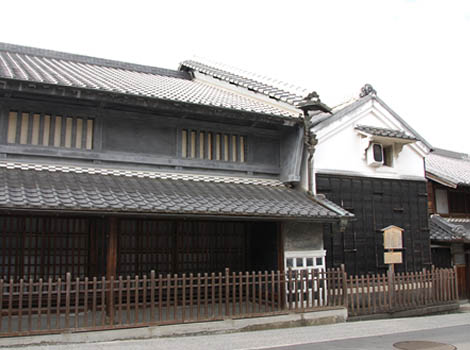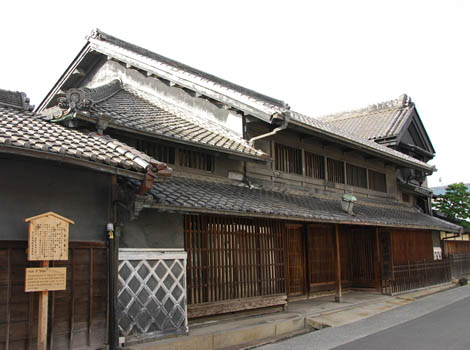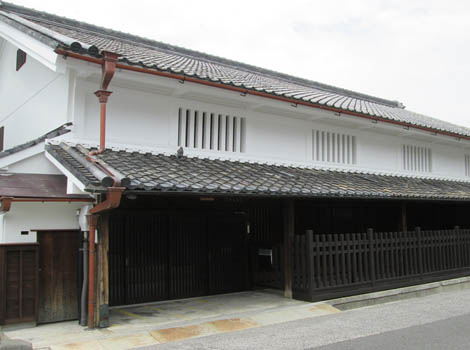



当住宅は、茶室の付く主屋、表倉、南倉などからなり、重厚広壮な有松の絞問屋の形態をよくとどめており、改造も少なく、建築的にも優れ、歴史的にもまた町並み景観の上からも貴重な建物です。
主屋は、木造切妻造二階建、桟瓦葺、平入り、外壁および軒裏は塗籠漆喰塗で、一階は格子窓、隣家との境に「うだつ」が設けられています。
主屋に付く茶室は、大高の長寿寺山に在住した茶人下村西行庵(1833~1916)の好みで、明治中期に建てられたものとされています。
小塚家が有松に移住した年代は、寛文年間(1661~1673)といわれ、屋号を山形屋として明治期まで絞り問屋を営んでいました。それ以後は専用住宅として使用され現在に至っています。
建築年:文久2年頃(1862頃)
名古屋市指定有形文化財(1992年)
参考文献:「名古屋市文化財報告書」他
現在の使用:住居 場所はこちら
The Kozuka house
This prized house, composed of the main house with a tearoom, a main warehouse and a south warehouses is a valuable building from a historical, scenic and architectural point of view. It still contains many of the original characteristics of the tie-dying warehouse with very little renovation.
The main wooden house of Kirizuma structure, with entrance on side has two stories and a gabled tiled roof construction. The outside walls are mud-plastered and under the eaves are coated with lacquer. On the first floor, there are lattice covered windows and Udatsu (a firewall built on the roof) are installed on both sides of the roof bordering the neighboring houses. The tearoom, beside the main house, is said to had been built around mid Meiji Era(1889~1904)and was a favorite of the tea master, Saigyou Simomura (1833~1916) who lived at Chojujisan in Odaka village. It is said that the Kozuka family settled in Arimatsu village in Kanbun year (1661~1673) and engaged in the wholesaling of Tie-dyeing under the trade name, Yamagataya, until the Meiji Era. After that, the house has been used as a private residence and still is today.
*Note;
Year of construction: Around Bunkyu Era 2nd(1862)
Status: Designated as a tangible cultural property By Nagoya City in 1992
Reference documents: Bibliography of Nagoya Cultural property report etc.
Current use: Residence


当住宅は、江戸時代末期の建築で、当時は丸屋丈助の店として、小田切春江の錦絵にも描かれています。
敷地は奥行が深く、主屋は木造切妻造二階建、桟瓦葺、土庇付の建物で、二階窓は優美な縦格子、塗篭漆喰塗になっています。お勝手の釜場の壁は、防火上の配慮から柱を巻き込んで塗りこめられた土壁が、独特の波形を描いています。
主屋の裏の敷地に、座敷、作業場、東倉、西倉が立ち並んでいます。有松の幕末における典型的な町屋形態を示しています。
建築年:江戸時代末期
名古屋市指定有形文化財(1987年)
参考文献:「名古屋市文化財報告書」他
現在の使用:住居 場所はこちら
The Oka house
This house was built in the late Edo period. The painter, Shunkou Odagiri painted the store (the store keeper; Jousuke Maruya) in the Nishikie (colored woodblock print). The wooden house of Kirizuma structure, built on a large lot, has a two stories and a gabled tiled roof construction with mud covered eaves. The second floor windows have graceful, vertical lattice coated with lacquer. The wall on the inside of the kitchen has a unique waveform shape in which pillars are coated with mud plaster for fire prevention. In back of the main house there is Tatami-mat room, a workshop and warehouses aligned east and west. This construction layout shows a typical Machiya(traditional townhouse) from the end of the Edo period in Arimatsu village.
*Note;
The year of construction: Late Edo Era
Status: Designated tangible cultural property By Nagoya City in 1987
Reference documents: Bibliography of Nagoya Cultural property report etc.
Current use: Residence


竹田家は、有松絞の開祖竹田庄九郎の後裔で300年以上の伝統を持ち、有松における代表的家系の一つです。
江戸末期における屋敷全体は、小田切春江によって描かれた俯瞰図でもうかがい知ることができ、正面外観の様子は、同じく春江の筆「尾張名所図絵巻之六」でも知られます。俯瞰図の右上に描かれている「申々居」は、春江院(緑区大高町)に移築され現存しており、棟の鬼瓦には、家紋の菱印が認められます。
主屋は、木造切妻造二階建、桟瓦葺、平入りですが、明治から大正にかけて屋根を上げ、しっかりした2階形式にし、表側に下屋(庇)を付設し土庇にしたり、出格子窓を造り、併せて、「申々居」移築あとの敷地に新たに書院が建造され、主屋と書院との間の間取りも大幅に改築されています。また、屋敷内の南方に、築200年以上とされる茶室「裁松庵」があります。
同家の造りは、絞問屋としてはもとより、接客用としての性格も強く、右側の門や玄関、書院、茶室などはこれらを具体的に示すものです。外観の偉容は、全盛時代の有松の豪華さを誇った代表的な建築の面影を偲ぶことが出来ます。
建築年:江戸期(主屋)
名古屋市指定有形文化財(1995年)
参考文献:「有松町並み調査報告書」
現在の使用:絞り商 場所はこちら
The Takeda house
The Takeda family is a descendant of the Shokuro Takeda, the founder of Arimatsu tie-dyeing. They are one of the dominant families in Arimatsu with the traditions of more than 300 years.
The painter, Shunkou Odagiri had drawn a bird's-eye view of the Takeda house facade constructed at the end of Edo Era in the Nisikie,
The appearance of the entrance of the house was also painted in the 6th volume of “Owari Meisho Zue”(Owari famous place drawings) by Shunkou Odagiri.
The SINSINKYO , drawn at the upper right of the (bird's-eye view or panoramic view) drawing still exists today after being removed and rebuilt at Shunnkouin (Odaka Town,Midori ku, Nagoya city) and the "Hisigata (diamond-shape)", family crest is recognized in the Onigawara(Japanese style gargoyle roof tile) on the end of roof ridge.
The main wooden house of Kirizuma structure, with side entrance has two stories and a gabled tile roof construction. The roof has been rebuilt to it in order to have a full second story. On the face of the house, geyabisashi (new mud-plaster eaves) and bay lattice windows had been built, also a Shoin (guest house of Japanese style) had newly be constructed at a vacant lot of “SINSINKYO” transferred to another place. The arrangement of the rooms between the main house and the Shoin has been largely rebuilt through the Meiji and Taisho Era.
On the south side of the lot there is the tea-ceremony room called “Saishou-An (pine-planting room) which is considered to have been more than 200 years after built.
The Takeda House strongly demonstrates not only the character of a tie-dying wholesaler but also a house that can accommodate waiting customers. The right gate and entrance of the house, the Shoin, and the tea-ceremony room are good examples of the above.
The stately appearance of the building shows the features of a typical wealth merchant building from the glory years of Arimatsu.
*Note; The year of construction: Around Edo Era
; Status: Designated a tangible cultural property By Nagoya City in 1995
; Reference documents: Bibliography of Nagoya Cultural property report etc.
; Current use: wholesale


中濵家住宅は、有松東海道に面して建つ町屋で、主屋を中心に西側に土蔵、東側に塀・物置と、有松の大規模な絞り問屋に見られる典型的な屋敷構えとなっています。建築面積240㎡、木造、厨子(ツシ)2階建、切妻造桟瓦葺、平入りの商家で、1階は正面全体を木格子で統一し、江戸期の蔀戸を採用せず、雨戸を入れたり出格子を採用し、内部には、入口から裏口までの片土間式を採用しています。2階は、軒を出桁造とし、虫籠窓を並べ、黒漆喰で塗籠めています。
屋敷を囲む塀および石垣は、西側の塀は腰を杉皮張りとし、東側は人の頭の大きさの玉石を積んだ擁壁が連続し、北側手越川面は切石を積み上げた精密な亀甲積みの擁壁となっています。明治時代に遡る遺構と考えられ、これら敷地境界の石垣も手越川沿いの歴史的景観を形成する貴重な工作物となっています。塀に沿った山与遊歩道から塀、石垣が観察できます。
建築年:明治中期頃
国登録有形文化財(2008年)
参考文献:「文化財ナビ愛知」
現在の使用:絞り商 場所はこちら
Nakahama House
Nakahama house was built along Arimatsu Tokaido. A main building in the center, a dozou (a mud-wall storehouse) in the west and a storeroom and a fence at the east make up a typical Layout of large scale estate of Arimatsu’s tie-dyeing wholesaler. With having total floor area of 240 m2, this merchant house is wooden, with Tsushi second floor, of Kirizuma structure, with tiles on a roof, with side entrance. On the first floor, the concept of the exterior front appearance is all lattice. Rain doors are used in place of Shimido(a door made with wood lattice on both sides of the board) of Edo period style. Bay latticed windows are also adopted. Interior-wise, Katadoma earth floor occupies through the front entranc to the back entrance . The second floor has the eaves extending broadly and Mushiko windows which are coated with black plaster.
The middle part of the fences in the west is made of Cedar bark. In the east, boulder stones in the size of human head are piled on top of each other to make up long walls. The wall on the north side facing the Tegosi-gawa River pile up hewn stones in the way of tortoiseshell manner. These stone walls have preserved the remains of a Meiji Period relic and become necessary component to form the historical landscape along the Tegosi-gawa River.
It will be fully observed these fences and stone walls from Yamayo esplanade on the Tegoshi-gawa River side.
The year of construction : Around Mid Meiji Period
Tangible cultural property stipulated by National government in 2008
Reference documents: Cultural assets navigator Aichi
Current use: Tie-dyeing busines


服部豊家は、寛政2年(1790)向かいにある大井桁屋から分家し、創業した絞問屋で、屋号を井桁屋といいます。屋敷地は、有松東海道に面し広い間口を有し、中央部に2階建の主屋を配し、井戸屋形、土蔵、門など併せて11棟が県指定文化財となっています。有松の有力な絞問屋の屋敷構の典型として価値のある遺構となっています。
主屋は、切妻造り、2階建、桟瓦葺、1階には格子をはめ、2階は黒漆喰の塗籠造りで屋根両妻にうだつを上げています。
主屋の西は、往還沿いに塀を構え、門を入ると座敷が建っています。明治30年(1877)頃、久田流の師匠であった西行庵の指導のもと建造されたもので、欄間や床の間などに趣向を凝らす端正な数寄屋風書院です。
敷地背面には、米蔵、味噌蔵、女中部屋、長屋門、裏座敷、藍蔵等が連続して建っています。これらの土蔵は、白漆喰の塗籠造りで、中庭側の腰は海鼠壁、外側は下見板張としています。藍倉、米蔵は、敷地段差を利用した三階建てとなっていて、開口部に格子を入れた北側の外観は城郭の櫓を思わせます。
主屋背面には、二階建ての宝蔵倉が建ち、宝蔵倉は他の蔵より一段棟が高い土蔵で主屋と同じ黒漆喰仕上げです。
有松の有力な絞り問屋の屋敷構えを建築的に特徴づけるものは、間口の大きな敷地の中に、絞りの原材料製品のための蔵、接客用の座敷などが立ち並ぶ構成といえますが、服部豊家はその典型といえ、よく保存された屋敷構え全体が価値あるものです。
建築年:文久元年(1861年)
愛知県指定有形文化財(1964年)
参考文献:「文化財ナビ愛知」
現在の使用:絞り商 場所はこちら
The Yutaka Hattori house
The Yutaka Hattori house was established as a branch family from the large house of Oigeta-Ya(The ancestor of the Igeta-Ya) across the street. They started business as a tie-dying wholesaler under the trade name of Igeta -Ya in Kansei Era 2nd (1790). The house sits on a large site facing the Arimatsu Old Tokai-Do highway and the two-story wooden main house is located at the center of the site. The house includes eleven buildings all in a row. The buildings include for example the well shed, the gate, the storehouse and others. All of them have been designated as a tangible cultural property by Aichi Prefecture and are priceless historic examples of a typical wealthy wholesaler’s residence in Arimatsu town. The main wooden house has two stories and a gabled tile roof with Udatsu (Firewall on the roof) construction on both ends of the roof. Wooden latticed windows are attached at the front of the first floor and the second floor has Mushikomado windows (windows with lattice covered by black colored plaster).
Along the highway on the west side of the main house, there is a gate in the wall, with a Zashiki(a Japanese-style drawing room )located there. The room had been built as a Shoin (guest house of Japanese style) around Meioji Era 30th (1877), and was under the instruction of Saigyou-an who taught Hisada style in the room. Ranma (a carved wooden panel), Tokonoma(alcove) etc. are incorporated in the handsome Sukiya style.
At the back of the site, a Komegura(rice granary), Miso gura(soybean paste granary), Jochu beya(maids' room), Nagaya mon (gate to a tenement house style),Urazasiki(back parlor),Aigura(indigo dying material storehouse) are built in succession. The mud-plaster walls of those storage building are coated with white lacquer. The middle of the mud-plaster wall on the courtyard side used Namako nuri(sea‐cucumber style court) and the outside walls are covered in clapboard siding. Komegura and Aigura are three stories which step built using the slope.
From the north side, the appearance of the lattice windows is reminiscent of a castle tower.
At the back of the main house, there is a two story treasury storehouse.
The top of the roof is higher than that of the other buildings on the site and the walls are black plasterwork. This house’s architecture is characteristic of buildings owned by influential tie-dying wholesale dealers in Arimatsu town and includes storehouses for raw material products and a waiting room for customers. This Hattori compound is typical in that sense, and this well- reserved house is valuable asset for us.
*Note; The year of construction: Bunnkyuu Era 1st (1861)
; Status: Designated a tangible cultural property By Aichi Pre.in 1964
; Reference documents: the Cultural assets navigator Aichi
; Current use: Tie-dye dealer


服部良也家は、服部家(井桁屋)から明治時代に東隣に分家した家柄です。この主屋の西側に建つ土蔵は、分家に際して服部家(井桁屋)から服部家(井桁一)に譲られたもので、県指定の文化財となっています。
倉は、二階建、切妻造、桟瓦葺で、建造は江戸末期と見られています。妻を東海道側に向けて立ち、1階・2階の各1ヶ所に窓を開いています。切石の土台の上に建ち、白漆喰の塗籠造、腰を海鼠壁とする外観は、西隣の服部孫兵衛家の表倉と一連のものとして調和しており、東海道沿いの景観要素として貴重です。
主屋建築年:明治28年(1895年)
倉建築年:江戸末期
愛知県指定重要文化財(1987年)
参考文献:「文化財ナビ愛知」
現在の使用:住居 場所はこちら
Yoshiya Hattori Residence
Hattori(Igeichi) got independent from the Hattri (Igeta-ya) and build the residence on the eastside of the Igeta-ya.
The storehouse on the westside of the main building was handed over by Igeta-ya as an assets of the branch family and designated as a tangible cultural property by Aichi Prifecrur.
The two storied storehouse on hewn stones has the gabled roof of Kirizuma structure and placed a windows facing to Tokai-do on the each floors and is said to be constructed the end of the Edo era.
Upper side of outer wall is coated with white plaster and bottom of wall is Namako-kabe(wall of a building covered with square tiles jointed with raised plaster).
The overall appearance lined with the Hattori’s (Igeta-Ya) front storehouse is to be looked like one series of constructions and makes historical and valuable landscape.
The year of construction of the residence: Around 28th Meiji era (1895)
The year of construction of the storehouse: Around End of Edo era
Status: Designated a tangible cultural property by Aichi pre. In 1987
Reference documents: Cultural assets navigator Aichi
Current use :Residence


棚橋家住宅は、間口の広い大店(おおだな)が続き重厚な町並みを形成する有松において、その由来にふさわしい規模と構成を今日に伝える遺構であり、町並みを形成する重要な景観要素となっています。
建物は、有松を代表する絞り問屋服部家住宅の遺構であり、分家した服部孫兵衛家が「井桁屋」の屋号としたので、本家は「大井桁屋」と呼ばれています。
大井桁屋服部家と棚橋家との関係は、昭和7年(1932)、名古屋医科大学の医局から派遣された棚橋龍三氏が有松で開業することになり、空家となっていた大井桁屋服部家の建物で開業したことに始まります。昭和25年(1950)、棚橋家は服部家から屋敷地を購入、龍三氏逝去後の昭和63年(1988)に医院は有松駅北へ移転したが、建物は旧状を維持しています。
主屋は、有松東海道に北面して建ち、ツシ2階建、桟瓦葺、平入の町屋です。前面2階は塗籠で、格子窓と壁を交互に配する構成で、1階は東半分を土庇としています。また、側面妻壁
は塗籠としています。
建物前面のセミ廻りの内部は、医院時代、また以後の住宅としての改変があり、診療室としえ使用するために天井は大引きを撤去して高く張り直していますが、地下には旧状を残しています。2階はツシ2階の形状で、物置となっています。小屋組みは和小屋で、全面の梁は登梁状に湾曲した材を架けています。(「木造ツシ2階建」のツシとは、「厨子」と書き、天井の低い屋根裏部屋のことを表します)
建築年:明治8年(1875年)
国登録有形文化財(2009年)
参考文献:「文化財ナビ愛知」
現在の使用:住居 場所はこちら
<参考文献>
「名古屋市文化財報告書 文化財叢書第93号」
「有松町並み調査報告」
(1975年 名古屋市教育委員会)
「名古屋市歴史的風致維持向上計画」第2章の4
「文化財ナビ愛知」
Tanahashi residence
The residence of the Tanahashi is a valuable
Architectural remains that shows the size and
construction of the building which is worthy of
Arimatsu ‘s landscape among large-scale
merchant s in the town of early modern era.
The construction of the residence is a typical style
of Arimatsu tie-dyeing Wholesaler.
The trade name of the head family, the Hattori is called as of
O-Igeta-ya(original Igeta-ya) in order to distinguish to the trade name of
Igeta-ya, Magobei Hattori.
The relation between the Hattori and The Tanahashi is that Dr.Ryuzo
Tanahashi was sent by the medical office of Nagoya medical college to
open a medical office in the town at 7th Shouwa (1932) and utilized the vacant
residence of O-Igeta-ya’ . In 25th Shouwa 1950, he bought it and after
he passed away ,the office moved to the northern part of Arimatsu station
remaining the residence as it was.
The main entrance of the building on the north side is facing to the Tokaido .
The residence is Machi-ya style wooden house with Tsushi second floor and
tiles on a roof, and with side entrance of *1Hira-iri .
The front side of the second floor wall is applied by Nurigome, the exterior
front appearance is lined up a lattice window and a white plaster wall alternately.
The inside of the front Semi-mawari is modified in order to use the room for
Consulting room by lifting the ceiling up with taking O-hiki out as less as
possible original frame.
The second floor is designed as Thushi style and used for a storage. The shape
of wood beams for the ceiling are curved.
*1 Japanese traditional architectural structure where the building has its
mainentrance on the side which runs parallel to the roof's ridge
*2 The second floor with wood Thushi is a shallow room beneath the roof of a
building, called attic a small shrine original meaning is Buddhist altar.
The year of construction: 8th Meiji (1875)
Status: Tangible cultural property stipulated by National government in 2008
Reference documents: Cultural assets navigator Aichi
Current use : Residence
